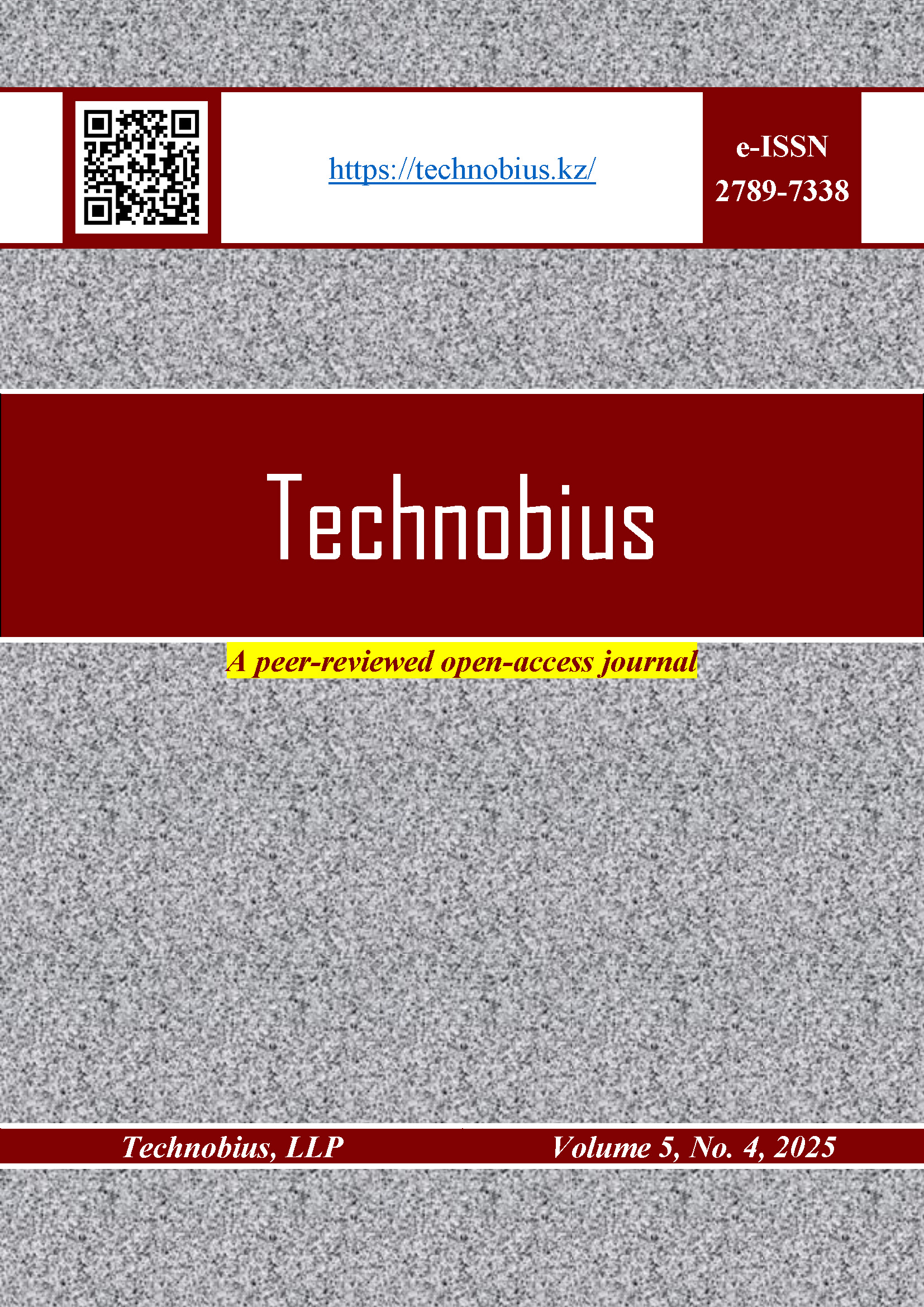Fine-grained self-compacting concrete with polyfunctional additive and enhanced performance properties
DOI:
https://doi.org/10.54355/tbus/5.4.2025.0089Keywords:
fine-grained self-compacting concrete, strength, calcium hydrosilicates, cement hydration, additivesAbstract
The results of experimental studies aimed at improving the strength characteristics of cement stone and fine-grained self-compacting concrete through the use of polyfunctional modifying additives based on nano-silicon dioxide (nano-SiO2) and micro-dispersed mineral components are presented. It was established that the introduction of 0.03% nano-SiO2 by weight of cement increases the compressive strength of cement stone by up to 32%, which is associated with the intensification of clinker mineral hydration processes, the formation of an additional amount of low-base calcium hydrosilicates, and an increase in the number of crystallization centers in the early stages of hardening. The effectiveness of the combined use of nano-SiO2 with microsilica and micro-calcite, which are similar in composition to cement but differ in structure and functional activity, has been experimentally confirmed. The use of two-component systems made it possible to increase the flexural strength of cement stone by up to 29% compared to the reference samples. The greatest effect was achieved by adding a polyfunctional three-component additive, including nano-SiO2, microsilica, and micro-calcite, to the composition of fine-grained self-compacting concrete. The use of this system increased the compressive strength of concrete by 44% (to class B60) and the flexural strength by up to 12.5 MPa (an increase of 53.7% relative to the reference composition). It was additionally established that the complex of additives contributes to the acceleration of self-organization processes in the early stages of hardening by increasing the density of crystallization centers and a more uniform distribution of hydration products in the cement matrix volume.
Downloads
Metrics
References
F. Sanchez and A. Borwankar, “Multi-scale performance of carbon microfiber reinforced cement-based composites exposed to a decalcifying environment,” Materials Science and Engineering: A, vol. 527, no. 13–14, pp. 3151–3158, May 2010, doi: 10.1016/j.msea.2010.01.084. DOI: https://doi.org/10.1016/j.msea.2010.01.084
L. A. Suleymanova, Pogorelova I.A., A. S. Slepuhin, and S. I. Plehova, “To the question of condition survey of the civil buildings,” Bulletin of Belgorod State Technological University named after. V. G. Shukhov, vol. 1, no. 9, pp. 63–66, 2016. DOI: https://doi.org/10.12737/22028
“GOST 25192-2012 Concretes. Classification and general technical requirements,” Moscow: Standardinform, 2012, p. 10.
J. Newman and B. S. Choo, “Advanced Concrete Technology,” Amsterdam, Netherlands: Elsevier, 2003, p. 280. doi: 10.1016/B978-0-7506-5686-3.X5246-X. DOI: https://doi.org/10.1016/B978-0-7506-5686-3.X5246-X
A. V. Fedorov and V. N. Aksenov, “To the question of the use of high-strenght concrete in compressed of tall buildings,” Engineering Journal of Don, vol. 50, no. 3, p. 102, 2018.
A. I. Karlina, Y. I. Karlina, and V. A. Gladkikh, “Analysis of Experience in the Use of Micro- and Nanoadditives from Silicon Production Waste in Concrete Technologies,” Minerals, vol. 13, no. 12, p. 1525, Dec. 2023, doi: 10.3390/min13121525. DOI: https://doi.org/10.3390/min13121525
S. V. Makarenko, “Cements with low water demand as an alternative type of binding mixture used in ready-mixed concrete,” Izvestiya vuzov. Investitsii. Stroitelstvo. Nedvizhimost, vol. 13, no. 1, pp. 58–63, Nov. 2023, doi: 10.21285/2227-2917-2023-1-58-63. DOI: https://doi.org/10.21285/2227-2917-2023-1-58-63
P. Richard and M. Cheyrezy, “Reactive Powder Concretes With High Ductility and 200 - 800 Mpa Compressive Strength,” in “SP-144: Concrete Technology: Past, Present, and Future,” Farmington Hills, MI: American Concrete Institute, 1994, pp. 507–518. doi: 10.14359/4536. DOI: https://doi.org/10.14359/4536
“GOST 31108-2020 Common cements. Specifications,” Moscow: Standardinform, 2020, p. 29.
“GOST 8267-93 Crushed stone and gravel of solid rocks for construction works. Specifications,” Moscow: Standardinform, 1993, p. 21.
“GOST 26633-2015 Normal-weight and sand concretes. Specifications,” Moscow: Standardinform, 2015, p. 15.
“GOST 8736-2014 Sand for construction works. Specifications,” Moscow: Standardinform, 2014, p. 21.
P. V. Kosmachev, “Poluchenie nanorazmernogo dioksida kremniya plazmenno-dugovym metodom iz vysokokremnezemistogo prirodnogo syrya,” Tomsk, Russia: TGASU, 2018, p. 141.
“GOST 58894-2020 Silica fume for concretes and mortars. Specifications,” Moscow: Standardinform, 2020, p. 19.
“GOST R 56775-2015 Microcalcite. for construction materials. Specifications,” Moscow: Standardinform, 2015, p. 12.
“GOST 30459-2008 Admixtures for concretes and mortars. Determination and estimate of the efficiency,” Moscow: Standardinform, 2008, p. 18.
“GOST 12730.5-2018 Concretes. Methods for determination of water tightness,” Moscow: Standardinform, 2018, p. 26.
“GOST 12730.1-2020 Concretes. Methods of determination of density,” Moscow: Standardinform, 2012, p. 18.
“GOST 10180-2012 Concretes. Methods for strength determination using reference specimens,” Moscow: Standardinform, 2012, p. 36.
E. V. Korolev, “Nanotechnology in material science. Analysis of chievements and current state,” Construction Materials, pp. 47–78, 2014.
A. V. Nomoev, V. T. Lygdenov, L. A. Urkhanova, and S. A. Lkhasaranov, “Fine-grained cement concrete with nanodispersed modificator,” Nanotehnologii v stroitelʹstve, vol. 2, no. 4, pp. 42–52, 2010.
Y. Qing, Z. Zenan, K. Deyu, and C. Rongshen, “Influence of nano-SiO2 addition on properties of hardened cement paste as compared with silica fume,” Constr Build Mater, vol. 21, no. 3, pp. 539–545, Mar. 2007, doi: 10.1016/j.conbuildmat.2005.09.001. DOI: https://doi.org/10.1016/j.conbuildmat.2005.09.001
T. V. Kuznecova and C. B. Samchenko, “Mikroskopiya materialov cementnogo proizvodstva,” Moscow: MIKHiS, 2007, p. 304.
M. Zaichenko, S. Lakhtaryina, O. Yegorova, V. Gubar, and A. Sokolova, “Optimization of cement stone composition with microsilicasuspension additive and SIKA VISCOCRETE SUPERPLASSIFIER 5 NEW ST,” Modern industrial and civil construction, vol. 14, no. 1, pp. 5–12, 2018.
I. A. Iochinskaya, Vliyanie kompleksnyh dobavok na processy gidratacii i tverdeniya portlandcementa: Avtoreferat dis. kand. tehn. nauk: 05.23.05. Moscow, 1974.
Yu. M. Bazhenov, “Concrete Technology,” Moscow: ACB, 2011, p. 528.
“GOST 10060-2012. Concretes. Methods for determination of frost-resistance,” Moscow: Standardinform, 2018, p. 24.
Published
How to Cite
License
Copyright (c) 2025 Zhanar Zhumadilova, Assel Kanarbay, Daniyar Akhmetov, Assel Aldigaziyeva

This work is licensed under a Creative Commons Attribution-NonCommercial 4.0 International License.
Funding data
-
Ministry of Education and Science of the Republic of Kazakhstan
Grant numbers AP27511185








